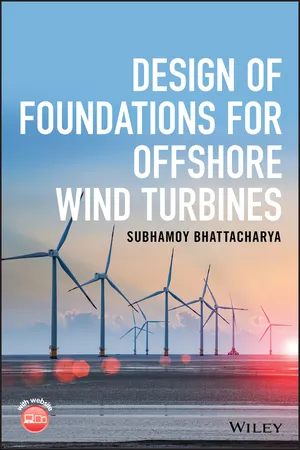
- English
- ePUB (mobile friendly)
- Available on iOS & Android
Design of Foundations for Offshore Wind Turbines
About This Book
Comprehensive reference covering the design of foundations for offshore wind turbines
As the demand for "green" energy increases the offshore wind power industry is expanding at a rapid pace around the world.
Design of Foundations for Offshore Wind Turbines is a comprehensive reference which covers the design of foundations for offshore wind turbines, and includes examples and case studies. It provides an overview of a wind farm and a wind turbine structure, and examines the different types of loads on the offshore wind turbine structure. Foundation design considerations and the necessary calculations are also covered. The geotechnical site investigation and soil behavior/soil structure interaction are discussed, and the final chapter takes a case study of a wind turbine and demonstrates how to carry out step by step calculations.
Key features:
- New, important subject to the industry.
- Includes calculations and case studies.
- Accompanied by a website hosting software and data files.
Design of Foundations for Offshore Wind Turbines is a must have reference for engineers within the renewable energy industry and is also a useful guide for graduate students in this area.
Frequently asked questions
Information
1
Overview of a Wind Farm and Wind Turbine Structure
Learning Objectives
1.1 Harvesting Wind Energy
- The average wind speed over sea is generally higher and more consistent than onshore, making the offshore wind farming more efficient.
- The noise and vibrations from the wind turbines will have minimum impact on human beings due to their distance from land.
- Large capacity can be installed offshore in comparison to an equivalent onshore wind farm. The reasons are that heavier wind turbine generators (WTGs) or towers can be easily transported and installed using sea routes. In contrast, transporting these large and heavy structures/components during construction will substantially disrupt the daily ...
Table of contents
- Cover
- Table of Contents
- Preface
- About the Companion Website
- 1 Overview of a Wind Farm and Wind Turbine Structure
- 2 Loads on the Foundations
- 3 Considerations for Foundation Design and the Necessary Calculations
- 4 Geotechnical Site Investigation and Soil Behaviour under Cyclic Loading
- 5 Soil–Structure Interaction (SSI)
- 6 Simplified Hand Calculations
- Appendix A: Natural Frequency of a Cantilever Beam with Variable Cross Section
- Appendix B: Euler‐Bernoulli Beam Equation
- Appendix C: Tower Idealisation
- Appendix D: Guidance on Estimating the Vertical Stiffness of Foundations
- Appendix E: Lateral Stiffness KL of Piles
- Appendix F: Lateral Stiffness KL of Suction Caissons
- Bibliography
- Index
- End User License Agreement